In preparing the previous four stories about U.S. Civil War sites and their histories, I gathered and posted a number of related photographs. And I was left with dozens more to choose from. If you’re one who believes the old adage that “a picture is worth a thousand words” and that photographs as well as words tell stories, you may be hungry for more images of the terrible conflict, and what’s left of the places where bloody battles took place.
So I’ve scooped up 25 more photos and, with a few lines of explanation, present them for your inspection and contemplation. The aren’t perfectly packaged from a graphic point of view. Consider them a slightly ragged pile of pictures that you came across and want to leisurely browse.
I’ve arranged them, as best I can, in roughly the same, chronological order as my previous narrative.
The vintage, black-and-white photographs of the period are taken from the Library of Congress collection. So are the photos of paintings.
The current photographs are the work of my peripatetic wife and traveling companion, Carol M. Highsmith, whose work adds so much to virtually every posting that I produce.
This assortment will give you one more taste, 150 years after it was fought, of the war that still resonates in American life and in the writings of historians and novelists the world over.

More than 150 years later, evidence of the shelling of Fort Sumter remains.
_

The gravesite of Judith Henry, killed by Yankee shells at the First Battle of Bull Run.
_

A lithographic depiction of the Battle of Cornith, Mississippi.
_

This statue, called the “Altar of Remembrance,” was erected at what’s left of the Fort Donelson battle site.
_

Here, and in the woods behind this fence, a bloody encounter took place on the Shiloh battlefield in 1862. Those who fought there called it “The Hornet’s Nest.”
_

Not a pleasant image, but a classic photo of the battlefield dead by Mathew Brady or one of his associates. As I mentioned in a posting, after the Civil War, people were so sick of carnage that thousands of Brady’s photos were smashed or used as greenhouse windows. No one wanted to look at them any longer.
_
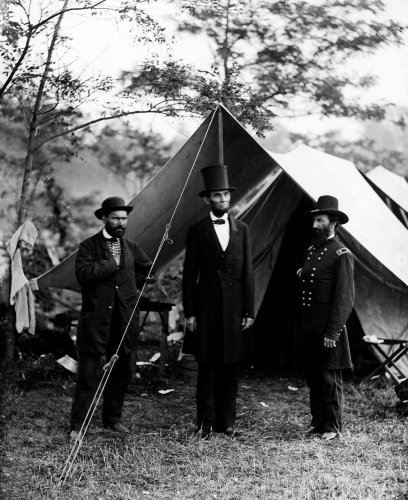
After the Union repulsed the Confederate invasion at the Battle of Antietam, President Lincoln rushed to congratulate the troops and scold commander George McClellan for allowing the Rebel army to escape back into Virginia. The president is shown here with his Secret Service chief, Allan Pinkerton, and Union General John McClernand.
_
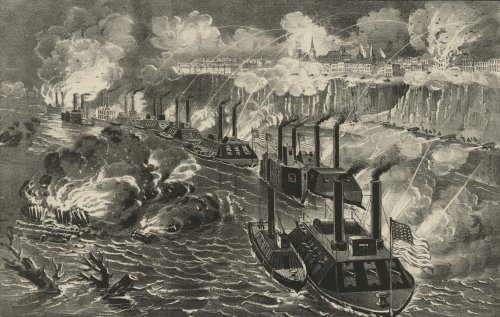
In this Currier and Ives lithograph, the Union Navy is shown running the Confederate blockade of the Mississippi River at Vicksburg in 1863.
_

Although Gettysburg and Antietam, and maybe Shiloh, battlefields probably draw greater tourist traffic, Carol and I found the Vicksburg Military Park along the Mississippi River to be the most beautiful, interesting, and easy to grasp. The story of a besieged populace reduced to living in caves was certainly compelling, too.
_

Union soldiers relax over a game of dominoes in camp at Yorktown, Virginia.
_

This is the spot called “The Wheatfield” on the Gettysburg battlefield, which one site devoted to the battle calls “a swirling and confused whirlpool of fighting and death.” The grain crop was left trampled and soaked in blood.
_
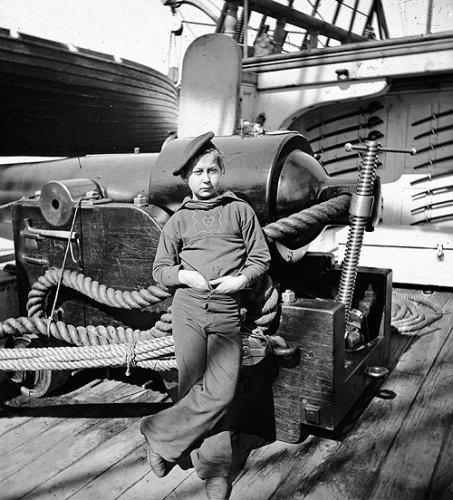
This is a young “powder monkey” on the U.S.S. New Hampshire, one of the Yankee ships that patrolled the Atlantic coast, blockading southern ports.
_

There are lots of portraits of Robert E. Lee, including many for which he posed after the war. But I thought this one best depicted his soulful eyes and careful grooming.
_

This stone tower, shaped like a chess rook, at the Chickamauga battlefield in Georgia, honors the Union’s “Lightning Brigade.”
_

I wrote about the Union’s arms superiority, and this photo, taken at Broadway Landing on the Appomattox River, gives you an idea of what the Federals brought to the fight.
_

This “chromolithograph” depicts Union commander Ulysses S. Grant’s military career, from his days as a West Point cadet to the Union’s final victory and acceptance of the Confederate surrender in south-central Virginia.
_

A colorful depiction of the death of Union major general James McPherson at the Battle of Atlanta. The sweeping novel and movie Gone With the Wind vividly described the fall of that vital railroad hub, and of the end of a courtly but (for slaves) harsh way of life.
_

At the 11-month-long Battle of Petersburg, opposing artillery batteries relentlessly shelled each other’s fortifications. This is a “bomb-proof” enclosure at what was officially called “Fort Sedgwick” but known by its men as “Fort Hell.”
_

Wars are often fought in humble locales, and the armistices that follow are sometimes signed in such places as well. This is the unassuming cabin in Appomattox Court House, Virginia, where the long and grinding Civil War officially came to an end. It would take weeks, however, for word to spread to all parts of the land and for the last shot between Union and Confederate forces to be fired.
_

This is Carol’s photo taken from John Wilkes Booth’s vantage point behind President Lincoln, who was watching a lighthearted play with his wife when the assassin shot the president in the back of the head with a .44-caliber Derringer. This was just five days after Robert E. Lee had surrendered, and the Union that Lincoln had devoted four years and thousands of soldiers’ lives to preserve, was saved.
_
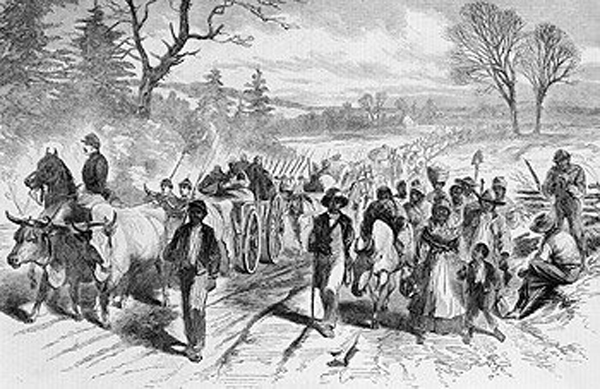
Harper’s Weekly magazine published this view of southern slaves, freed by the Union Army, streaming into what became, in effect, refugee camps. President Lincoln had declared the captives free, but not until northern troops overran the towns and plantations of the South did that freedom become real. The freedmen and women would face decades of additional repression once the army left following “Reconstruction.”
_

Thousands of monuments and memorials, grand and simple, rose in commemoration of the Civil War and the service of ordinary men and women on both sides. One of my favorites is a frieze that extends 370 meters entirely around the old Pension Building, now the National Building Museum, in Washington, D.C. The creation of sculptor Caspar Buberi incorporates 28 different scenes. The Italianate building, which is often used for presidential inaugural balls, was designed by former Union quartermaster general Montgomery Meigs, who, you may recall from my earlier postings, also got Arlington National Cemetery started.
_
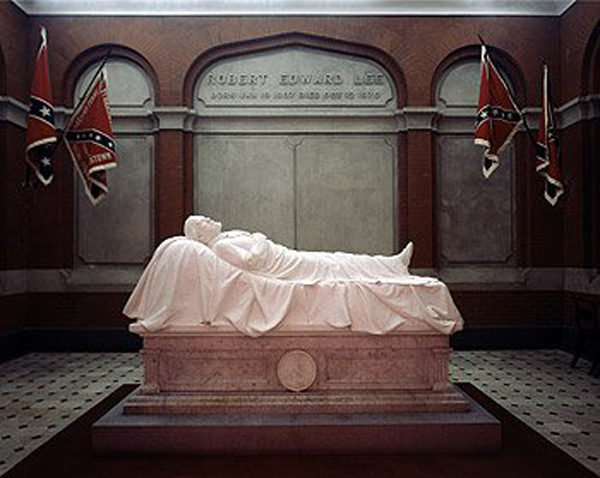
I thought Carol’s image of what’s called the “Recumbent Lee” statue at Washington and Lee University in Lexington, Virginia, would be a fitting close to the discussion of the Civil War. In retirement, Lee was president of what was then Washington College, and at his death, this statue, depicting the revered general asleep on the battlefield, was created by Edward Valentine inside the college chapel. It is often mistakenly identified as his tomb, understandably, since he is buried beneath the chapel. And his faithful, battle-hardened horse, Traveller, is interred outside.
Ted's Wild Words
These are a few words from this posting that you may not know. Each time, I'll tell you a little about them and also place them into a cumulative archive of "Ted's Wild Words" in the right-hand column of the home page. Just click on it there, and if there's another word that you'd like me to explain, just ask!
Lithograph. A difficult and highly creative copy of a painting or photograph. Lithography involves drawing a mirrored image of the original, using greasy crayons, onto a smooth stone, upon which paper is laid and pressed to create the lithographic image.
Peripatetic. An adjective describing one who travels, or more accurately wanders, about, often restlessly.


2 responses to “Civil War Photo Bonus”
No offense, but shouldn’t it be peripatetic?
Dear CabOverPete:
You’re absolutely right that I originally misspelled “peripatetic.” I’ve corrected it, so you’ll never know what a butchery I made of it! Shame on me, since I went on and DEFINED the incorrectly spelled word in my “Wild Words.”
We have a saying around here referring to the need for “two pairs of eyes” being a useful thing for every story (and blog). Three, in cases like this!
Don’t hesitate to backstop me on any mistakes that I’ve made. I value accuracy as well as creativity.
Thanks again, Pete.
Ted